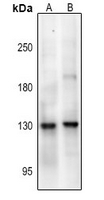


| WB | 咨询技术 | Human,Mouse,Rat |
| IF | 咨询技术 | Human,Mouse,Rat |
| IHC | 1/50-1/100 | Human,Mouse,Rat |
| ICC | 1/100-1/200 | Human,Mouse,Rat |
| FCM | 咨询技术 | Human,Mouse,Rat |
| Elisa | 咨询技术 | Human,Mouse,Rat |
| Aliases | GLURZ1; GRIN1; N-methyl-D-aspartate receptor; NMZ1; NMDZ1 |
| Entrez GeneID | 2902; |
| WB Predicted band size | 105kDa |
| Host/Isotype | Rabbit IgG |
| Antibody Type | Primary antibody |
| Storage | Store at 4°C short term. Aliquot and store at -20°C long term. Avoid freeze/thaw cycles. |
| Species Reactivity | Human,Mouse,Rat |
| Immunogen | Peptide sequence around phosphorylation site of serine890(A-S-S(p)-F-K) derived from Human NMDAR1 . |
| Formulation | Purified antibody in PBS with 0.05% sodium azide. |
+ +
以下是关于NMDAR1 (Phospho-Ser890)抗体的3篇参考文献的简要概括:
1. **文献名称**:*"Regulation of NMDA receptor trafficking by PKC phosphorylation of Serine 890"*
**作者**:Sanchez-Perez et al.
**摘要**:该研究通过使用Phospho-Ser890特异性抗体,证明PKC激活后磷酸化NMDAR1的Ser890位点,促进受体从细胞膜内吞,从而调节突触传递和神经元可塑性。
2. **文献名称**:*"Phosphorylation-dependent targeting of NMDA receptors via AP2 adaptor complexes"*
**作者**:Hisatsune et al.
**摘要**:文章利用NMDAR1 (Phospho-Ser890)抗体,揭示该位点的磷酸化增强了NMDAR与AP2复合物的结合,导致受体内化,影响突触后膜受体的稳定性。
3. **文献名称**:*"Dynamic regulation of NMDA receptor surface expression by PKC and PP1"*
**作者**:Lau et al.
**摘要**:通过免疫印迹和免疫荧光技术(使用Phospho-Ser890抗体),研究发现PKC和磷酸酶PP1通过调控Ser890磷酸化水平,动态平衡NMDAR在神经元表面的表达,影响学习记忆功能。
以上文献均聚焦于该抗体在揭示NMDAR1磷酸化调控机制中的应用,涉及受体内化、突触可塑性及信号通路等领域。
The NMDAR1 (Phospho-Ser890) antibody is a specialized tool used to detect the phosphorylation state of the NMDA (N-methyl-D-aspartate) receptor subunit GluN1 (NR1) at serine residue 890. NMDA receptors are ionotropic glutamate receptors critical for synaptic plasticity, learning, and memory. The NR1 subunit is essential for receptor assembly and function, with post-translational modifications like phosphorylation regulating receptor trafficking, localization, and activity. Phosphorylation at Ser890. located within the intracellular C-terminal domain of NR1. is mediated by protein kinase C (PKC) and influences receptor internalization. This site-specific modification disrupts interactions with scaffolding proteins, promoting clathrin-dependent endocytosis of NMDA receptors, thereby modulating synaptic strength.
The Phospho-Ser890 antibody is widely used in neuroscience research to study activity-dependent changes in receptor distribution, particularly in contexts like long-term depression (LTD), excitotoxicity, or neurological disorders. It enables detection of dynamic phosphorylation events in brain tissue or cultured neurons through techniques like Western blotting, immunohistochemistry, or immunofluorescence. Studies using this antibody have highlighted its role in linking PKC signaling to synaptic NMDA receptor availability, offering insights into mechanisms underlying neuropsychiatric diseases, epilepsy, and ischemic injury. Proper validation with phosphorylation-deficient mutants or PKC inhibitors is recommended to ensure specificity.
×